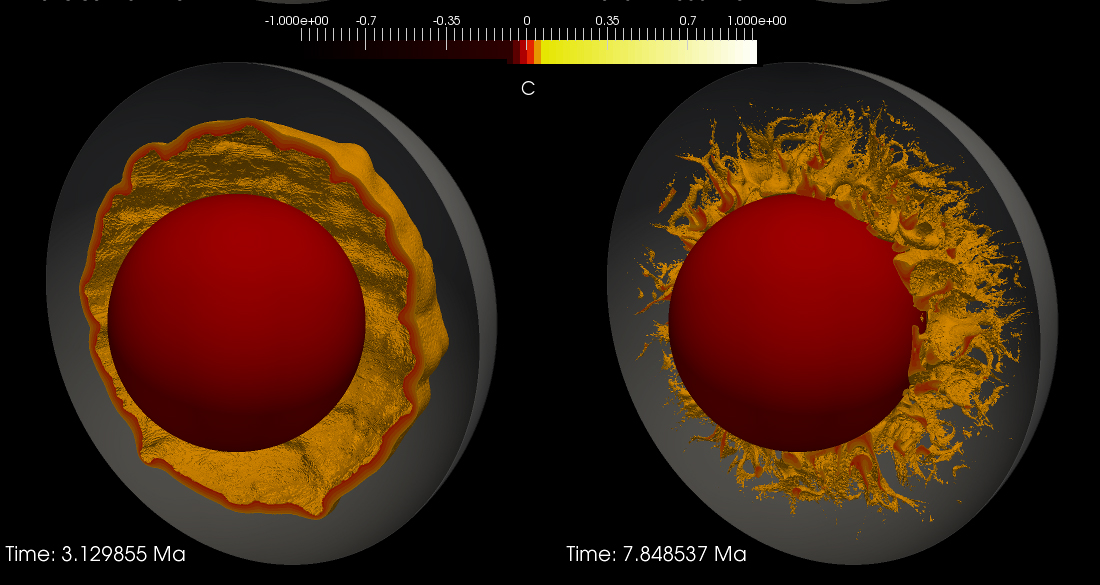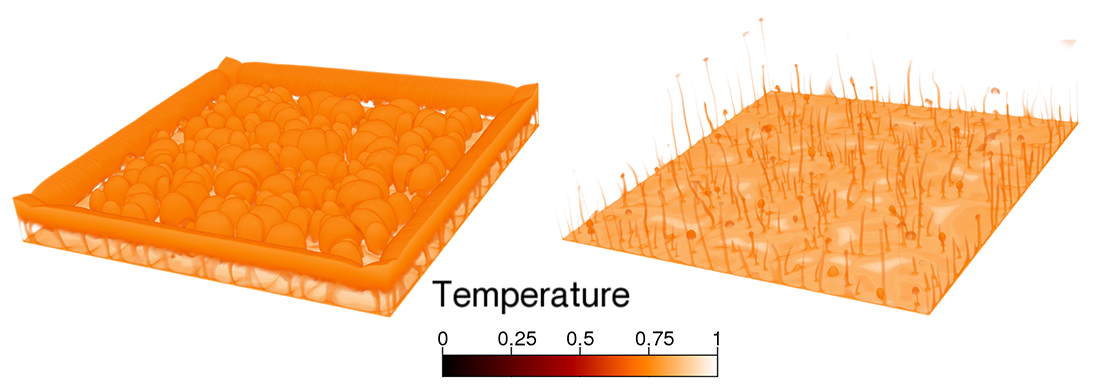ASTROPHYSICS
Mantle Thermo-Chemical Convection Simulations (MATHECO)
Principal Investigator:
Ana-Catalina Plesa
Affiliation:
German Aerospace Center/DLR, Berlin (Germany)
Local Project ID:
MATHECO
HPC Platform used:
Hornet of HLRS
Date published:
Scientists of the German Aerospace Center Berlin (DLR) exploited the computing capacity of the petascale system Hornet of HLRS to study the convective dynamics and evolution of planetary interiors. The goal of the large-scale simulation project MATHECO (MAntle THErmo-chemical COnvection Simulations), which scaled to 54,000 compute cores of the supercomputer Hornet, was to gain further insights into the cooling history of planets and its influences on volcanic and tectonic surface processes.
Key Facts:
• 54,000 compute cores
• 3 machine hours
• 2 TB of data
• 50 million grid points with more than 200 million unknowns
• 1,325 time steps
The dramatic increase of computational power over the past decade has rendered numerical models of the dynamics of planetary interiors, a fundamental tool for understanding the complex processes that shape the interior of terrestrial bodies across our Solar System and beyond.
In project MAntle THErmo-chemical COnvection Simulations (MATHECO), researchers of the Institute of Planetary Research of the German Aerospace Center, Berlin, performed large-scale numerical simulations of solid-state mantle convection using the finite-volume code GAIA [Hüttig et al., 2013; Plesa et al., 2015]. The code is a fluid flow solver that employs a fixed grid in arbitrary geometries to solve the conservation of mass, momentum, energy, and chemical transport. It is used for modelling Stokes-flow with strongly varying viscosity, a scenario often met in geophysics and particularly in mantle convection simulations. Apart from thermally driven convection compositional changes along with their effects on buoyancy can be accounted for. To accurately track compositional fields, the scientists employed tracer particles (Fig. 1). The ability to use such technique in various geometries makes GAIA unique among mantle convection codes. The code is written in C++ and does not need additional libraries, thus being easily portable on various systems.

Fig. 1: Overturn of an unstable density gradient. The iso-volume shows the dense material sinking and accumulating at the core-mantle boundary. The simulation uses a 12 million points computational grid (corresponding to 60 million degrees of freedom) and additional 240 million tracer particles to accurately track compositional gradients. This computation was performed using 13 x 103 cores on the HLRS platform.
Copyright: German Aerospace Center (DLR), BerlinNumerical simulations of planetary interiors often use simplified approaches and limited parameter ranges in order to reduce computational costs. The convective vigor expressed in terms of the Rayleigh number is usually reduced and often a simplified mantle rheology needs to be adopted. The goal of this project is to unravel the dynamics of planetary interiors at high Rayleigh numbers (Fig. 2) as appropriate for the Earth’s mantle and in the presence of complex rheologies, such as pseudo-plastic ones that allow the researchers to model the emergence of tectonic plates in a self-consistent fashion.

Fig. 2: Thermal convection at high Rayleigh numbers. The iso-surface shows thermal instabilities which develop in a system heated both from below and from within at a very high Rayleigh number (Ra ≈ 1011) including a strongly temperature dependent viscosity. The simulation uses a computational grid with 54 million points (275 million degrees of freedom) and was performed on 54 x 103 compute cores of the HLRS supercomputer Hornet.
Copyright: German Aerospace Center (DLR), BerlinThe simulations using highly resolved meshes with up to 54 million grid-points necessary for the parameter ranges studied were performed on the Cray XC40 machine Hornet at the High Performance Computing Center Stuttgart (HLRS) using up to 54,000 compute cores. During the project, the scientists largely improved their code, making GAIA one of the few codes world-wide able to efficiently run large-scale simulations of interior dynamics. High-performance computational centers like HLRS with its massive parallel computing resources make it possible to address complex fluid dynamical problems of planetary interiors and help improve the understanding of physical processes active in the interior of terrestrial bodies using realistic parameter values.
References:
[Hüttig et al., 2013] Hüttig, C.; Tosi, N.; Moore, W.B.: An improved formulation of the incompressible Navier-Stokes equations with variable viscosity. Physics of the Earth and Planetary Interiors, 11 - 18, 220, doi:10.1016/j.pepi.2013.04.002.
[Plesa et al., 2015] Plesa, A.-C.; Hüttig, C.; Tosi, N.; Breuer, D.: Thermo-Chemical Mantle Convection Simulations Using Gaia. High Performance Computing in Science and Engineering '14 ed. Wolfgang E. Nagel, Dietmar H. Kröner, Michael M. Resch, DOI:10.1007/978-3-319-10810-0.
Research Team and Scientific Contact:
Prof. Dr. Doris Breuer, Dr. Christian Hüttig, Dr. Ana-Catalina Plesa (PI), Dr. Nicola Tosi
German Aerospace Center, Institute of Planetary Research, Planetary Physics
Rutherfordstraße 2, D-12489 Berlin (Germany)
e-mail: Ana.Plesa@dlr.de
http://www.dlr.de/pf